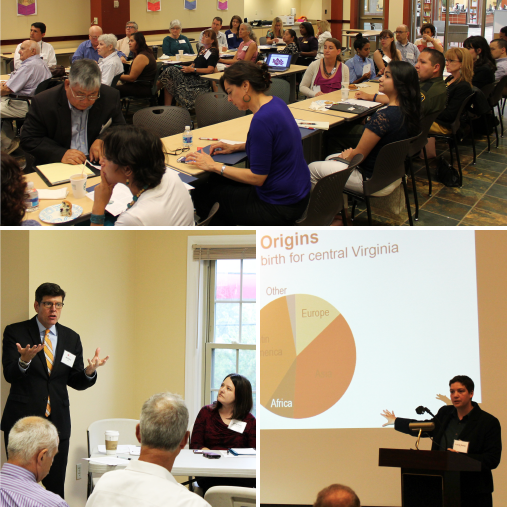June 4, 2015
Bringing It Home: Discussing Immigration in the Shenandoah Valley and Central Virginia

(top) Participants filled the meeting room at the Meadowdale Library in Chesterfield where Senior Policy Analyst Levi Goren (bottom right) unpacked the key findings from the Central Virginia report. (bottom left) TCI President Michael Cassidy facilitates the discussion at the Harrisonburg-Rockingham Chamber of Commerce where business leaders, advocates, faith leaders, and other community stakeholders heard about the key findings for the Shenandoah Valley.
Provide interpretation services as part of job search programs, not just within the unemployment insurance application system. Provide a pathway for immigrants without legal status to participate in our driver licensing system so that all drivers on the road are trained, licensed, insured, and accountable. Help highly educated refugees transfer their credentials so they can work in their area of expertise.
These are just a few of the ideas that were brought up by community leaders during two immigration forums we hosted this week in Harrisonburg and Richmond. We organized these events with local co-sponsors to discuss the findings and policy implications of our new reports on the economic contributions of immigrants in the Shenandoah Valley and Central Virginia.
In the two published reports we found that immigrants bring a valuable array of experiences and make critical contributions to the economies of both regions.
Foreign-born residents are more likely than non-immigrants to be in their prime working years, for example, and most are currently working. This has important economic implications, since it means these workers are mostly contributing to the economy right now, rather than sometime in the past or future. And while immigrants are from across the world, with no dominant country of origin in either region, most are very rooted in the United States—half have been in the United States for more than 15 years, and many are naturalized U.S. citizens.
However, our analysis shows that foreign-born residents of both regions also face some particular challenges.
For example, immigrants in both the Shenandoah Valley and Central Virginia are much less likely than their non-immigrant peers to have health insurance, perhaps partly because Virginia is particularly stingy about the availability of public coverage for non-citizens. And despite the fact that there are many well-educated immigrant workers with higher incomes, particularly in central Virginia, in both regions there are a chunk of adult immigrants who have relatively low levels of education and lower incomes.
The conversations we held this week to discuss these findings and policy implications were enriched by the wide array of community leaders who attended, including business leaders, non-profit service providers, immigrant advocates, workforce development providers, and faith leaders. We’ll host a third forum on June 15 in Virginia Beach where we’ll release a report on economic contributions of immigrants in Hampton Roads. Click here for more information or to register for that event.
Meanwhile, you can find copies of the Central Virginia and Shenandoah Valley reports on our Web site.
Working together to solve these challenges can help make sure all of our workers and families are thriving in our communities. We look forward to continuing to broaden the conversation on how to make sure public policy in Virginia reflects the lives and needs of all of us, not just some of us.
To get plugged in, please contact us and we can connect you with advocates doing work in your area of the state.
Special thanks to our co-sponsors for these events:
The Harrisonburg-Rockingham Chamber of Commerce; the Spencer Center for Civic & Global Engagement at Mary Baldwin College; The Virginia Hispanic Chamber; New Bridges Immigrant Resource Center; the Virginia Asian Chamber of Commerce; Legal Aid Justice Center; the Sacred Heart Center; the Hampton Roads Hispanic Chamber of Commerce; the Asian Business Association; and the League of Women Voters of South Hampton Roads.
